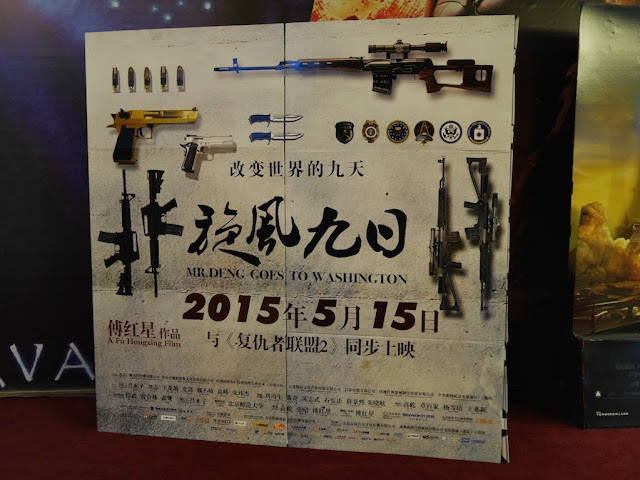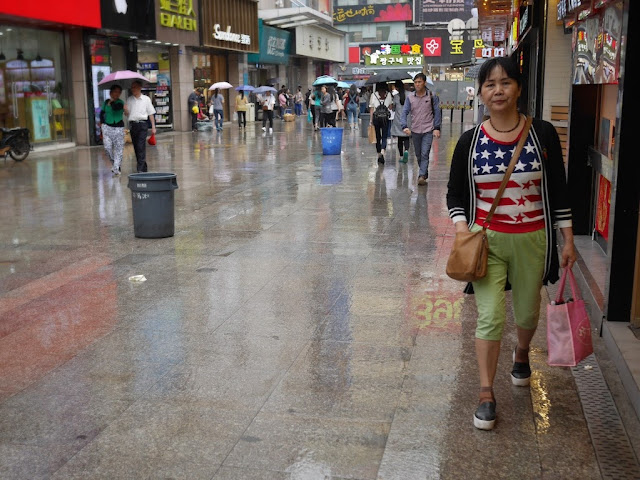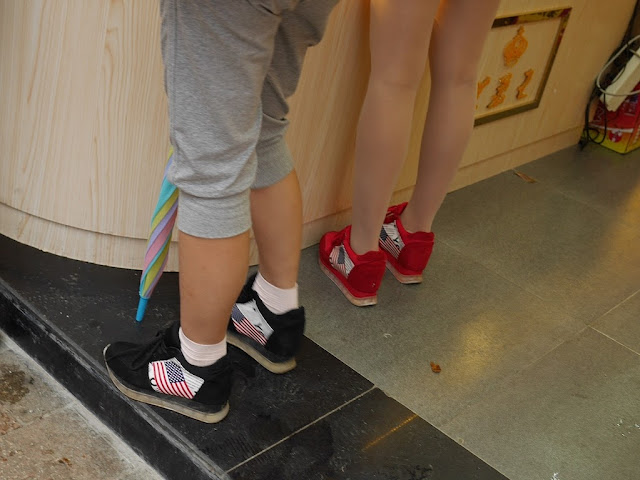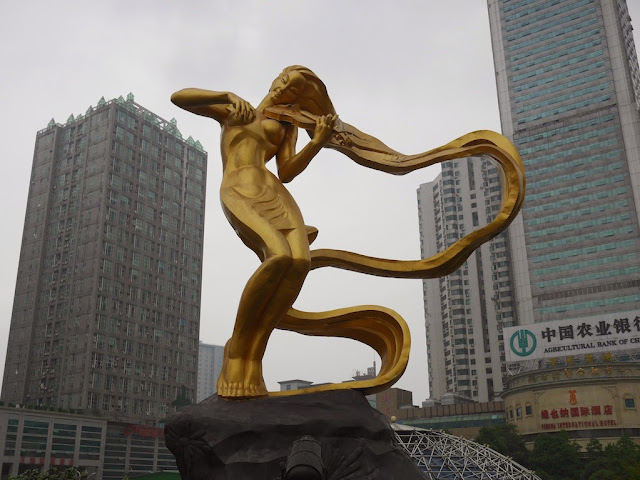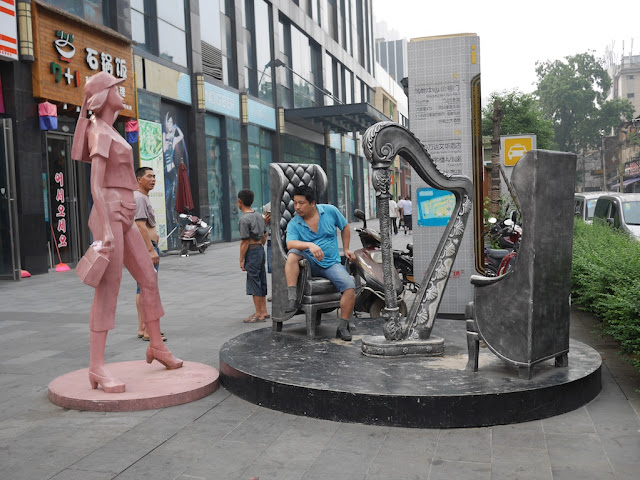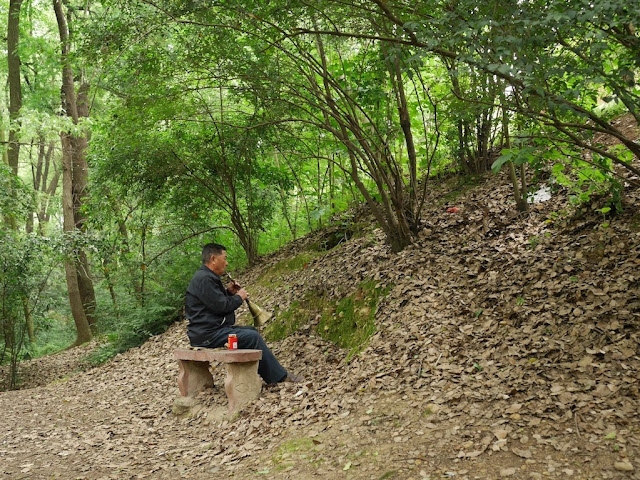The historical documentary "Mr. Deng Goes to Washington" opened last month in Chinese theaters. The Telegraph summarized the movie and mentioned one of the film's more unusual aspects:
Here is a poster I saw for the film at a movie theater in Changsha:
The numerous guns and knives aren't what I would expect based on the above descriptions of the movie, but they may reflect Qin's observation that the film "places equal, if not greater, emphasis on Deng’s personal security during his visit as on the content of his meetings and discussions with American leaders." And in The Financial Times Lucy Hornsby shares examples of Chinese media describing an attack on Deng shown in the film as an assassination attempt.
But Hornsby adds a small detail which complicates that story:
The above poster hasn't been the only advertisement for the film I have seen in a theater. Just over a week before the film's opening day, in Xiangtan, another city in Hunan, I saw one which took a significantly different approach. It displayed a nearly life-size cutout of a person well-recognized in China. But it wasn't Deng Xiaoping:
At the time of Deng's visit to the U.S., seventeen year-old Barack Obama probably didn't suspect it would lead to his likeness someday standing in a Hunan movie theater.
One of the questions I am left with after considering the curious use of guns and Obama to promote a film about Deng's historic visit is "If people unfamiliar with the film were presented with only these two advertisements, what would they guess its plot to be and would they want to see it?"
At least they might provide some great ideas for new movies.*
*Added note: I wrote this sentence without anything much more specific in mind than a) some people may come up with interesting plots, perhaps suitable for action movies, and b) I suspect many of these plots would significantly differ from the advertised movie's. After rereading the post, I now appreciate there is another possible interpretation of the sentence, and it is one I did not wish to express or imply. So to be absolutely clear, I am not at all suggesting there should be a movie about the assassination of Barack Obama or that such a movie would be a great idea.
The film tells the story of Deng's nine-day visit to the US in 1979, only a month after China established diplomatic relations with the US for the first time after the founding of the People's Republic of China in 1949.In a piece on Sinosphere describing challenges the independently produced documentary faced in gaining Chinese government approval, Amy Qin highlighted other details:
Telling stories of Chinese leaders through animation is very rare in China, but Mr Deng Goes to Washington interweaves historical footage, interviews and animated images of Deng.
The film, which cost $4 million to make, features interviews with important figures on the American side such as President Jimmy Carter; Mr. Carter’s national security adviser, Zbigniew Brzezinski; and Henry A. Kissinger, national security adviser under President Richard M. Nixon who helped broker the 1972 summit meeting among Mr. Nixon, Premier Zhou Enlai and Mao Zedong that paved the way for Mr. Deng’s visit.Even if the film now seems intriguing, it could be challenging to make a documentary a big draw at Chinese theaters. Advertisements in movie theaters can offer a window into what aspects of a film marketers think will most capture people's attention and encourage them to purchase a ticket. So with all this in mind . . .
By weaving together interviews and footage of Mr. Deng’s visit, much of which was purchased from American media networks, [director Fu Hongxing] said he wanted to help Chinese audiences understand the importance of that visit to China’s present-day success.
Here is a poster I saw for the film at a movie theater in Changsha:
The numerous guns and knives aren't what I would expect based on the above descriptions of the movie, but they may reflect Qin's observation that the film "places equal, if not greater, emphasis on Deng’s personal security during his visit as on the content of his meetings and discussions with American leaders." And in The Financial Times Lucy Hornsby shares examples of Chinese media describing an attack on Deng shown in the film as an assassination attempt.
But Hornsby adds a small detail which complicates that story:
In fact, Mr Deng was approached in a hotel lobby by a white supremacist who planned to spray him with red spray paint. The would-be assailant was punched by a member of Mr Deng’s secret service detail.In other words, the world was ever so close to there now being a documentary titled "Mr. Deng Leaves Washington Redder".
The above poster hasn't been the only advertisement for the film I have seen in a theater. Just over a week before the film's opening day, in Xiangtan, another city in Hunan, I saw one which took a significantly different approach. It displayed a nearly life-size cutout of a person well-recognized in China. But it wasn't Deng Xiaoping:
At the time of Deng's visit to the U.S., seventeen year-old Barack Obama probably didn't suspect it would lead to his likeness someday standing in a Hunan movie theater.
One of the questions I am left with after considering the curious use of guns and Obama to promote a film about Deng's historic visit is "If people unfamiliar with the film were presented with only these two advertisements, what would they guess its plot to be and would they want to see it?"
At least they might provide some great ideas for new movies.*
*Added note: I wrote this sentence without anything much more specific in mind than a) some people may come up with interesting plots, perhaps suitable for action movies, and b) I suspect many of these plots would significantly differ from the advertised movie's. After rereading the post, I now appreciate there is another possible interpretation of the sentence, and it is one I did not wish to express or imply. So to be absolutely clear, I am not at all suggesting there should be a movie about the assassination of Barack Obama or that such a movie would be a great idea.

